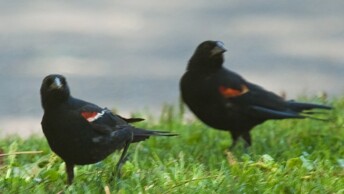Florida is one of the best places in the country to watch birds, with a mix of familiar backyard visitors and striking species you won’t see in many other states. From the noisy Boat-tailed Grackle strutting along parking lots to the Palm Warbler bobbing its tail in winter, these birds bring color and movement to every landscape. Whether you’re exploring a coastal marsh, walking through a neighborhood, or just glancing out the window, you’re almost guaranteed to spot something interesting.
This article will introduce you to some of Florida’s most common birds, with tips on where to find them and how to recognize their calls and habits. Once you start noticing them, you’ll see how much life these birds bring to everyday spaces.
1. Northern Cardinal
- Scientific name: Cardinalis cardinalis
- Life span: 3–15 years
- Size: 21–23 cm / 8.3–9.1 in
- Weight: 42–48 g / 1.5–1.7 oz
- Wingspan: 25–31 cm / 9.8–12.2 in
- IUCN Status: Least Concern
- State status: Breeding and common
- Migration pattern: Resident all year; does not migrate.
Northern Cardinals are a favourite sight in Florida gardens, spreading across the eastern United States and into Mexico. Males are a vibrant red all over, with a black mask around their heavy orange bill that makes their expression look striking and strong. Females are more muted, with warm tan feathers and subtle red accents on their wings and crest.
Their thick, triangular bill stands out against their soft plumage. Cardinals sing clear, whistling songs that carry easily, announcing their territory year-round in suburban yards, parks, and woodland edges.

Northern Cardinals build cup-shaped nests in dense shrubs or low trees. Females weave twigs, leaves, and grass into a tidy structure hidden among branches. Males stay nearby, singing persistently to claim territory and warn rivals away. Pairs often raise multiple broods in a season, returning to favoured spots each year.
They eat seeds, fruits, and insects. Cardinals often visit feeders for sunflower seeds and cracked corn. In breeding season, they gather beetles and caterpillars to feed nestlings. You can spot them hopping along the ground or clinging to branches, using their thick orange bills to crush tough seeds.
Cardinals have expanded their range northward thanks to suburban gardens with shrubs and winter feeding. They are protected by law and remain common across Florida. Their resilience means they need little direct conservation, though planting native plants benefits them and many other backyard birds.
2. Blue Jay
- Scientific name: Cyanocitta cristata
- Life span: 7 years on average
- Size: 9–12 in (22–30 cm)
- Weight: 2.5–3.5 oz (70–100 g)
- Wingspan: 13–17 in (33–43 cm)
- Status: Least Concern
- State status: Breeding and common
- Migratory behaviour: Remains year-round; no large migrations.
The Blue Jay is found widely across the eastern and central United States, including throughout Florida. This striking bird has bright blue wings and tail feathers marked with black barring and white highlights. Its face is framed by a bold black necklace and a crisp white throat. Blue Jays wear a tall, expressive crest that rises when excited.
In flight, their broad, rounded wings flash patches of pale blue. They are social and intelligent, often gathering in family groups that move noisily through oak trees and neighborhood feeders.

Blue Jays build sturdy cup nests high in the forks of trees, especially oaks and pines. Both sexes gather sticks, bark, and rootlets to shape the nest, lining it carefully with softer materials. They guard their nest with loud calls and aggressive swooping attacks on potential predators, including hawks and squirrels.
They eat a varied diet that includes acorns, insects, fruits, and seeds. Blue Jays are famous for caching food, burying acorns in hidden spots to retrieve later. They also visit feeders for peanuts and sunflower seeds. Their cleverness shows in how they test, hide, and remember countless food stashes each season.
Blue Jays are stable and widespread across Florida. Their habit of planting acorns helps oak forests regenerate naturally. They are protected under federal law, though no special conservation actions are required.
3. American Crow
- Scientific name: Corvus brachyrhynchos
- Life span: 7-8 years
- Size: 16-21 inches (41-53 cm)
- Weight: 11-21 ounces (315-595 grams)
- Wingspan: 33-40 inches (84-102 cm)
- Status: Least Concern
- State status: Breeding and common
- Migratory behaviour: Year-round resident; stays in same regions.
The American Crow is found throughout North America, including all parts of Florida. This large, all-black bird has a heavy bill and strong, steady flight. In sunlight, its feathers show hints of purple and green iridescence. Crows are known for their intelligence, using tools and working together to solve problems. Their loud cawing calls carry far across fields and neighbourhoods.

American Crows build large stick nests high in trees. Both sexes help construct the nest and line it with soft material. They guard their chosen territory together, chasing hawks, owls, or any intruder that comes too close. Families often reuse areas year after year.
They eat insects, grains, carrion, and human food scraps. Crows forage almost anywhere, walking confidently across fields or probing roadside trash. Their intelligence shows in how they solve problems and remember food sources.
American Crow populations are strong across Florida. Though West Nile Virus once caused declines, their numbers have rebounded. Conservation focuses on disease monitoring and protecting their diverse habitats, from farmlands to suburban neighbourhoods.
4. Mourning Dove
- Scientific name: Zenaida macroura
- Life span: 2–5 years
- Size: 9–13 in / 23–33 cm
- Weight: 4–6 oz / 112–170 g
- Wingspan: 17–18 in / 43–46
- Status: Least Concern
- State status: Breeding and common
- Migratory behaviour: Present all year; some local movements occur.
Mourning Doves range across all of North America and are a familiar sight in Florida’s cities, farms, and open woodlands. Their plumage is soft gray-brown, blending into sidewalks or bare branches. They have a small head and a long, tapered tail edged with white, creating a graceful silhouette in flight. When perched, you can see the subtle pinkish blush on their breast and the delicate black spots on their wings. Their mournful cooing calls drift across quiet mornings, adding a gentle soundtrack to parks and suburban yards alike.
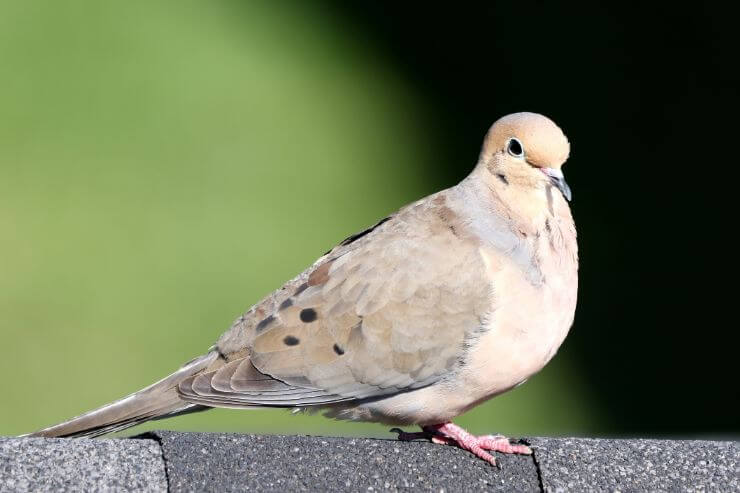
Mourning Doves build flimsy platform nests of twigs placed on horizontal branches, sheltered ledges, or even flowerpots. Females construct most of the nest while males bring materials. Their nests look sparse, sometimes allowing eggs to show through the bottom. Despite their delicate appearance, these nests can last for multiple broods throughout the long breeding season in Florida.
They primarily eat seeds collected from open ground. Mourning Doves forage calmly along fields, roadsides, and backyards, picking up grains and weed seeds. Unlike many other birds, they store food in their crop before moving to a safe perch to digest. Their gentle cooing and unhurried feeding habits make them familiar sights across all kinds of habitats.
Mourning Doves remain one of North America’s most abundant birds. Hunting regulations ensure populations stay healthy. Because they adapt easily to agricultural fields and suburban areas, conservation mainly focuses on habitat stewardship and monitoring harvest limits to prevent local declines. Their resilience has kept their numbers strong even as landscapes change.
5. Red-winged Blackbird
- Scientific name: Agelaius phoeniceus
- Life span: 2-3 years
- Size: 6.7-9.1 in (17-23 cm)
- Weight: 1.1–2.7 oz (32–77 g)
- Wingspan: 12–16 in (30–40 cm)
- Status: Least Concern
- State status: Breeding and common
- Migratory behaviour: Mostly resident; some move locally in winter.
Red-winged Blackbirds are widespread across North America, including marshes, fields, and roadside ditches in Florida. Males are unmistakable, with jet-black bodies and bold red and yellow shoulder patches that they flash while singing. Females are streaky brown and blend into reeds and grasses, making them harder to spot. Their liquid songs pour out from cattails in spring, and in winter, large flocks often gather in open areas. Watching them display is one of the most familiar sights in any wetland.
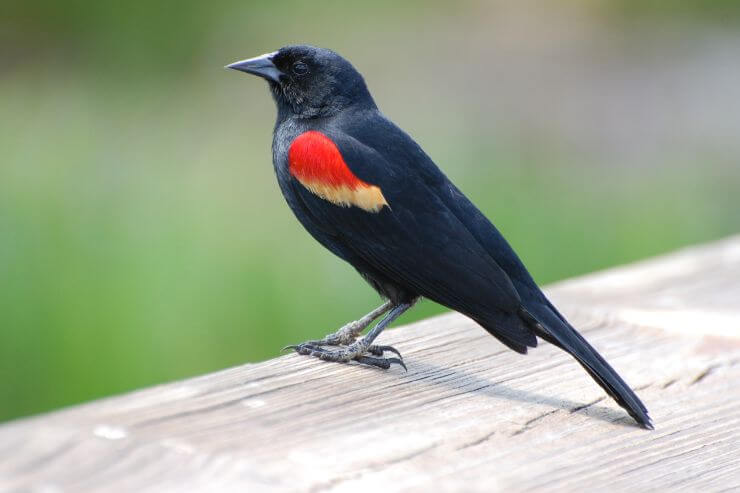
Red-winged Blackbirds nest low among cattails and reeds in marshes. Females weave a well-hidden cup secured to plant stems. Males perch nearby, singing loudly and flashing their red shoulder patches. One male may guard several nesting females in his territory, staying vigilant all season.
They eat insects in spring and summer, switching to seeds and grains later. Red-winged Blackbirds forage by walking through shallow water and fields, probing soil or picking grains. Their loud, bubbling calls echo across wetlands and farm fields where they gather in flocks.
Populations remain abundant across Florida. Wetland conservation helps sustain nesting habitat. Though sometimes considered agricultural pests, they are protected under federal law. Efforts focus on maintaining marshes while reducing conflicts in crop areas through non-lethal deterrence.
6. European Starling
- Scientific name: Sturnus vulgaris
- Life span: 2-3 years
- Size: 7.5–9 in (19–23 cm)
- Weight: 2.1–3.4 oz (60–96 g)
- Wingspan: 12–17 in (31–44 cm)
- Status: Least Concern
- State status: Breeding and common
- Migratory behaviour: Year-round resident; no migration.
European Starlings were introduced to North America and are now among the continent’s most common birds, thriving across Florida’s towns and farmlands. In breeding season, their plumage is sleek, iridescent black with green and purple reflections. In winter, white spots cover their bodies, giving them a speckled look. Their short tails and long, pointed bills set them apart from other blackbirds. Starlings gather in huge flocks that twist and turn in unison, creating impressive displays over fields and city rooftops.
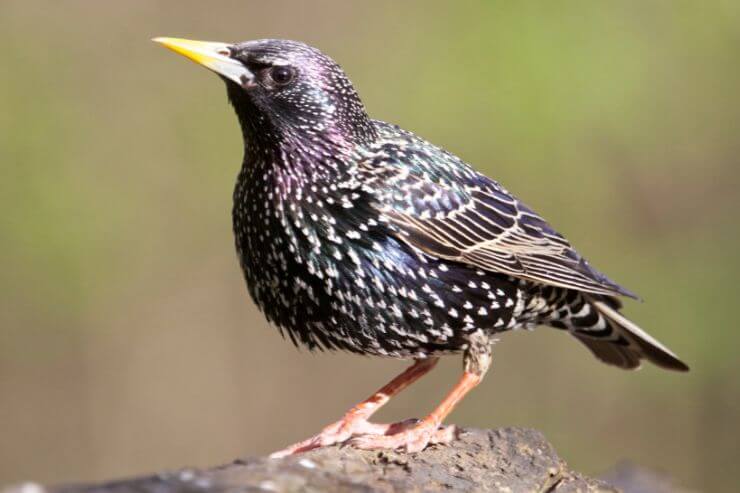
European Starlings nest in cavities in trees, buildings, and nest boxes. They fill holes with grass, feathers, and debris until the cavity is nearly stuffed. Pairs often reuse the same site each year, sometimes displacing native birds like woodpeckers or bluebirds.
They eat insects, fruits, grains, and scraps. Starlings forage on lawns for grubs and worms, then move to fruiting trees or feedlots. In winter, they gather in vast flocks that swirl through fields and roost noisily in city trees at dusk.
Starlings are non-native and spread rapidly after introduction. Though numerous, they are managed in some areas to protect native species. Monitoring helps track their impact on cavity-nesting birds and agriculture. Their adaptability means they remain one of North America’s most successful invasive birds.
7. Common Grackle
- Scientific name: Quiscalus quiscula
- Life span: 5-6 years
- Size: 11–13 in (28–34 cm)
- Weight: 2.6–5.0 oz (74–142 g)
- Wingspan: 14–18 in (36–46 cm)
- Status: Least Concern
- State status: Breeding and common
- Migratory behaviour: Present all year; flocks may shift locally.
Common Grackles are found year-round across Florida, as well as most of the eastern United States. Males have glossy, iridescent plumage that shifts from blue to bronze depending on the light, and pale yellow eyes that give them a watchful look. Their tails are long and keel-shaped, fanned wide when displaying. Females are duller and smaller but share the same distinctive shape. Grackles often gather in big, noisy flocks that fill trees and fields with harsh, metallic calls.
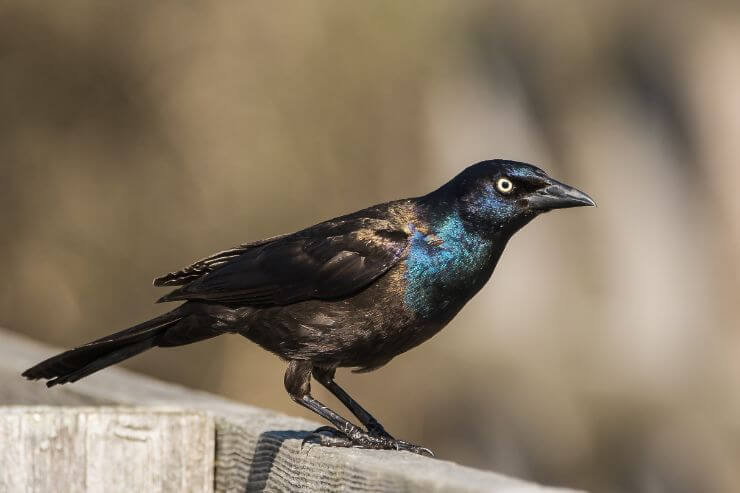
Common Grackles nest in loose colonies in trees or shrubs. Females build a bulky cup lined with grass and mud. Males stay nearby, displaying their iridescent feathers and calling in harsh, metallic tones to claim territory. They often return to the same trees each year.
They eat insects, grains, and small animals. Grackles forage boldly in fields, lawns, and parking lots, searching for anything edible. Their sharp bills pry open seeds and dig through debris. In fall, they join huge mixed flocks that sweep across open areas.
Common Grackles are widespread and secure. Though sometimes viewed as nuisances, they are protected under federal law. Conservation mainly involves monitoring to understand population trends and managing roosting flocks in urban settings to reduce conflicts.
8. Northern Mockingbird
- Scientific name: Mimus polyglottos
- Life span: 12-14 years
- Size: 8.1–10.2 in (20.5–26 cm)
- Weight: 1.4–2.0 oz (40–58 g)
- Wingspan: 12–15 in (30–38 cm)
- Status: Least concern
- State status: Breeding and common
- Migratory behaviour: Stays year-round; does not migrate.
The Northern Mockingbird is widespread throughout most of the United States, stretching into southern Canada and parts of Mexico. In Florida, it’s especially abundant, often seen perched boldly on fences, rooftops, and power lines. This bird has smooth gray upperparts and a pale breast, with white wing patches that flash when it flies. Its long tail flicks up and down as it surveys its surroundings. Mockingbirds are best known for their remarkable songs, which include endless imitations of other birds and even mechanical noises, making them a lively part of any neighborhood.
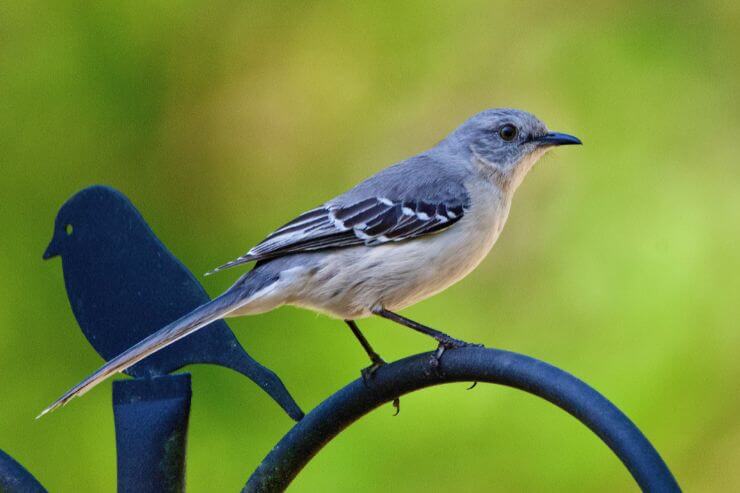
Northern Mockingbirds build bulky open cup nests low in shrubs or small trees, often hidden in dense tangles of branches. Females gather twigs, grasses, and leaves to shape the nest, while males defend the area with constant singing and aggressive displays. Pairs may raise two or even three broods in a season, fiercely protecting their chosen territory from intruders, including much larger birds.
They eat insects, berries, and fruit throughout the year. During breeding, they catch beetles, ants, and caterpillars by foraging on the ground or fluttering up to grab prey from leaves. In winter, they switch to berries like holly and wax myrtle. Mockingbirds are bold around feeders and gardens, often chasing away other birds to protect a good food source.
Though never considered rare, mockingbirds have benefited from suburban development, which provides the shrubs and small trees they prefer for nesting. They are protected under the Migratory Bird Treaty Act. Their adaptability has made them one of the most widespread songbirds in the Southeast. Monitoring continues to ensure populations remain stable as urban areas expand further.
9. Palm Warbler
- Scientific name: Setophaga palmarum
- Life span: Up to ~6 years
- Size: 4.7–5.5 in (12–14 cm)
- Weight: 0.3–0.5 oz (9–15 g)
- Wingspan: 7.9–8.3 in (20–21 cm)
- Status: Least concern
- State status: Migratory and common
- Migratory behaviour: Leaves by late April; returns in fall.
Palm Warblers breed far to the north in Canada’s boreal forests but spend winter throughout Florida, where they become one of the most common cold-season warblers. They have a yellowish belly and an olive-brown back, with a rusty cap that’s most vivid in spring. Their habit of constantly bobbing their tails makes them easy to recognize as they forage on the ground or in low bushes. Even in parking lot edges and weedy fields, their cheerful tail-wagging is a familiar winter sight.

Palm Warblers nest in northern bogs but winter abundantly across Florida. They build neat cup nests on or near the ground in dense sphagnum moss. During migration and winter, they stay in open fields, roadsides, and coastal habitats where they are easily observed.
They feed on insects and small berries. In winter, they forage low, constantly bobbing their tails while picking insects from grass and leaf litter. This distinctive tail-wagging makes them one of the easiest warblers to identify even from a distance.
Palm Warblers are common winter visitors and not considered at risk. Habitat conservation in both breeding and wintering grounds ensures they continue thriving. Birders contribute valuable migration data that helps scientists monitor long-term trends in their populations across the continent.
10. Boat-tailed Grackle
- Scientific name: Quiscalus major
- Life span: Up to ~12 years
- Size: 15–17 in (38–43 cm)
- Weight: 5–8 oz (140–230 g)
- Wingspan: 15–20 in (38–51 cm)
- Status: Least concern
- State status: Breeding and common
- Migratory behaviour: Stays year-round along coasts and wetlands.
The Boat-tailed Grackle is a classic Florida bird, found mainly along the southeastern and Gulf coasts. Males are glossy black with a long, keel-shaped tail that fans out behind them when they fly or display. Their pale eyes gleam against their dark face, and they often perch high to deliver loud, varied calls. Females look completely different, wearing warm brown plumage and a slimmer profile. These grackles gather in noisy flocks in marshes, parking lots, and coastal areas, where they are hard to overlook.
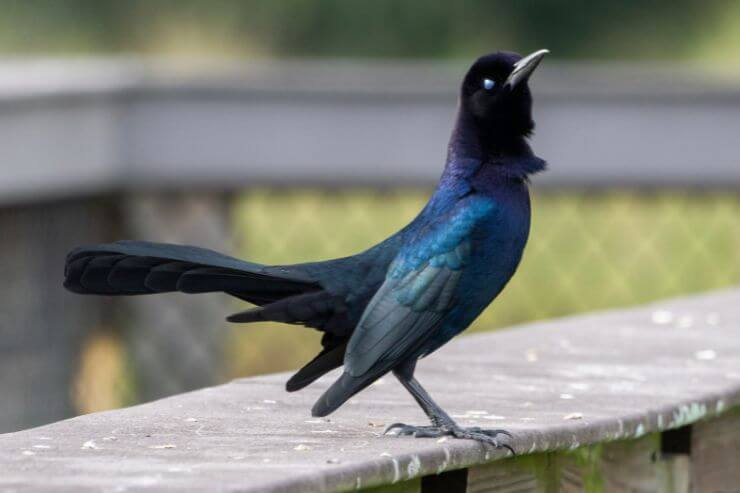
Boat-tailed Grackles nest in colonies among marsh vegetation. Females build deep cup nests woven into cattails or reeds, often just above the water. Males stay perched nearby, displaying and calling loudly. Colonies can be large, filling wetlands with constant movement and chatter as birds defend their nesting space.
They feed on insects, small crustaceans, seeds, and discarded food. Boat-tailed Grackles forage confidently in marshes, parking lots, and beaches. Their bold nature and ability to exploit many food sources make them highly adaptable. Males strut and call while feeding, keeping rivals at a respectful distance.
Grackle numbers remain strong across Florida. Because they thrive in both natural and urban wetlands, no intensive conservation measures are required. Management sometimes focuses on balancing their abundance with habitat protection for less common marsh birds sharing the same areas.
Where to look for Common birds in Florida
Florida’s common birds can be seen almost everywhere, from beach boardwalks to suburban yards. Early mornings are the best time to look, when birds are active and calling. Bring a pair of binoculars and move slowly, pausing to watch for movement in the trees or along the ground.
In open areas, look for Boat-tailed Grackles strutting boldly or Red-winged Blackbirds flashing their red shoulder patches. Palm Warblers are easy to spot in winter, constantly wagging their tails as they search for insects.
Four great places to see a variety of common birds are:
- Everglades National Park, where wetlands attract herons, grackles, and warblers
- Merritt Island National Wildlife Refuge, famous for large flocks in winter
- Corkscrew Swamp Sanctuary, where boardwalks wind through cypress forest alive with bird sounds
- Paynes Prairie Preserve State Park, which combines open marsh, prairie, and woodland. With a little patience, you’ll discover birds almost everywhere you go.
Conclusion
Florida’s common birds fill every corner with color, song, and movement. From the bright flashes of a cardinal to the lively calls of a mockingbird, they make any walk more interesting. Learning to spot them adds a layer of joy to exploring this beautiful, bird-rich state.

